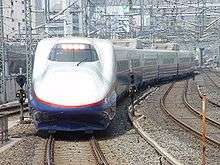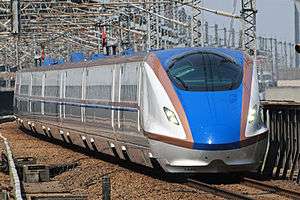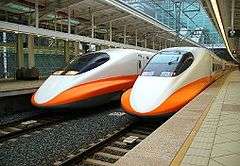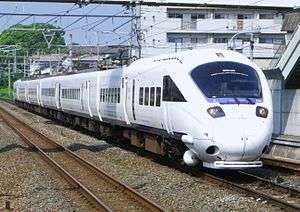800 Series Shinkansen
| 800 series | |
|---|---|
|
800 series train at Shin-Minamata station | |
| In service | 2004–Present |
| Manufacturer | Hitachi |
| Number built | 54 vehicles (9 sets) |
| Number in service | 54 vehicles (9 sets) |
| Formation | 6 cars per trainset |
| Fleet numbers | U001–U009 |
| Capacity | Original sets: 392 (Standard class only), New sets: 384 |
| Operator(s) | JR Kyushu |
| Depot(s) | Kumamoto |
| Line(s) served | Kyushu Shinkansen |
| Specifications | |
| Car body construction | Aluminium |
| Car length |
25,000 mm (82 ft 0 in) (intermediate cars), 27,350 mm (89 ft 9 in) (end cars) |
| Width | 3,380 mm (11 ft 1 in) |
| Height | 3,650 mm (12 ft 0 in) |
| Maximum speed | 260 km/h (160 mph) |
| Acceleration | 2.5 km/h/s |
| Electric system(s) | 25 kV AC, 60 Hz overhead catenary |
| Current collection method | Pantograph |
| Safety system(s) | KS-ATC |
| Track gauge | 1,435 mm (4 ft 8 1⁄2 in) |
The 800 series (800系) is a Japanese Shinkansen high-speed train type operated by JR Kyushu on the Kyushu Shinkansen high-speed rail line. Built by Hitachi, the trains were introduced on the Tsubame services from March 2004.
The 800 series has a maximum speed of 260 km/h (160 mph) in service, although its maximum design speed is 285 km/h (177 mph). It was one of the two recipients of the 45th Laurel Prize awarded by the Japan Railfan Club in 2005.
It abandons the 700's "duckbill" nose in favor of a sharper nose. The livery is white, with a red stripe.
Following the opening of the entire Kyushu Shinkansen route on 12 March 2011, 800 series trains were primarily used on all-stations Tsubame services operating mostly between Hakata and Kumamoto. They also operate some Sakura services within the Kyushu Shinkansen.[1]
Formation
| Car No. | 1 | 2 | 3 | 4 | 5 | 6 |
|---|---|---|---|---|---|---|
| Designation | Msc | Mp | M2w | M2 | Mpw | Mc |
| Numbering | 821 | 826 | 827 | 827-100 | 826-100 | 822-100 |
| Seating capacity | 46 | 80 | 72 | 72 | 66 | 56 |
Cars 2 and 5 are equipped with PS207K single-arm pantographs.[2]
Build history
| Set number | Date delivered[2] | Manufacturer |
|---|---|---|
| U001 | 30 August 2003 | Hitachi |
| U002 | 16 September 2003 | Hitachi |
| U003 | 6 October 2003 | Hitachi |
| U004 | 11 December 2003 | Hitachi |
| U005 | 28 December 2003 | Hitachi |
| U006 | 18 July 2005 | Hitachi |
Interior
The Kyushu Shinkansen runs a large portion in tunnels. Designers paid special attention to the interior design of the 800 series to create a more pleasant travel experience. More traditional materials and design features are used to embody Kyushu's warm and natural environment.
Persimmon tannin color is used for the walls, ancient lacquer for the doors, and Kyushu traditional rope curtain from Yatsushiroigusa for the lavatory are used. The seats are made of wood versus metal/plastic combinations from previous trains and the cushions are produced using Nishijin textiles. Window curtains are produced from prunus serrulata,[3] and interior flooring is also made of wood.[4]
Seating is four abreast (2 by 2), with wheelchair-accessible seating and lavatory facilities in two of the six cars.

New 800 series
JR Kyushu announced in December 2008 that three new 800 series sets would be delivered between summer 2009 and autumn 2010, ahead of the completion of the entire Kyushu Shinkansen route between Hakata and Kagoshima-Chūō in 2011.[5] The first of the new batch, set U007, was delivered in June 2009,[6] and entered service on 22 August 2009.[7] Externally, the new sets feature minor livery changes regarding the red stripe, and internally, each car features different colour seat covers.[8] Sets U007 and U009 include track condition monitoring equipment and are numbered in the 800-1000 series, while set U008 features overhead wire and signal monitoring equipment and is numbered in the 800-2000 series.[9]
Formation
| Car No. | 1 | 2 | 3 | 4 | 5 | 6 |
|---|---|---|---|---|---|---|
| Designation | Msc | Mp | M2w | M2 | Mpw | Mc |
| Numbering | 821-1000 | 826-1000 | 827-1000 | 827-1100 | 826-1100 | 822-1100 |
| Seating capacity | 46 | 80 | 72 | 72 | 58 | 56 |
Cars 2 and 5 are equipped with PS207K single-arm pantographs.[2]
Build history
| Set number | Date delivered[2] | Manufacturer | Remarks |
|---|---|---|---|
| U007 | 8 August 2009 | Hitachi | - |
| U008 | 19 March 2010 | Hitachi | Cars numbered 8xx-2xxx |
| U009 | 24 November 2010 | Hitachi | - |
Interior
-

Interior of car 826-1107 (car 5 of set U007)
-

Interior of car 822-1107 (car 6 of set U007)
See also
References
- JR全車輌ハンドブック2006 [JR Rolling Stock Handbook 2006]. Japan: Neko Publishing. 2006. ISBN 4-7770-0453-8.
- ↑ 平成23年春ダイヤ改正 [Spring 2011 timetable revision] (Press release) (in Japanese). JR Kyushu. 17 December 2010. Retrieved 2010-12-20.
- 1 2 3 4 JR電車編成表 2012夏 [JR EMU Formations - Summer 2012]. Japan: JRR. May 2012. ISBN 978-4-330-28612-9.
- ↑ ぼくは「つばめ」のデザイナー 九州新幹線800系 誕生物語. Japan: Kodansha. 2004. p. 71. ISBN 4-06-212532-3.
- ↑ "懐九州新幹線つばめ / 800系新幹線電車". Retrieved on 28 May 2009.(Japanese)
- ↑ "懐かしくて新しいインターナショナルな新800系の誕生" (17 December 2008). Retrieved on 18 December 2008.(Japanese)
- ↑ Japan Railfan Magazine: "新800系が川内に到着" (New 800 series arrives at Sendai) (24 June 2009). Retrieved on 26 June 2009. (Japanese)
- ↑ Japan Railfan Magazine: "新800系,8月22日に営業運転を開始" (New 800 series to enter revenue service on 22 August) (3 August 2009). Retrieved on 4 August 2009. (Japanese)
- ↑ Rail Magazine: "新800系第1編成が完成。" (2 August 2009). Retrieved on 5 August 2009 (Japanese)
- ↑ 新800系登場 (New 800 series). Japan Railfan Magazine. Japan: Koyusha. 49 (582): 75–81. October 2009.
External links
| Wikimedia Commons has media related to 800 Series Shinkansen. |





